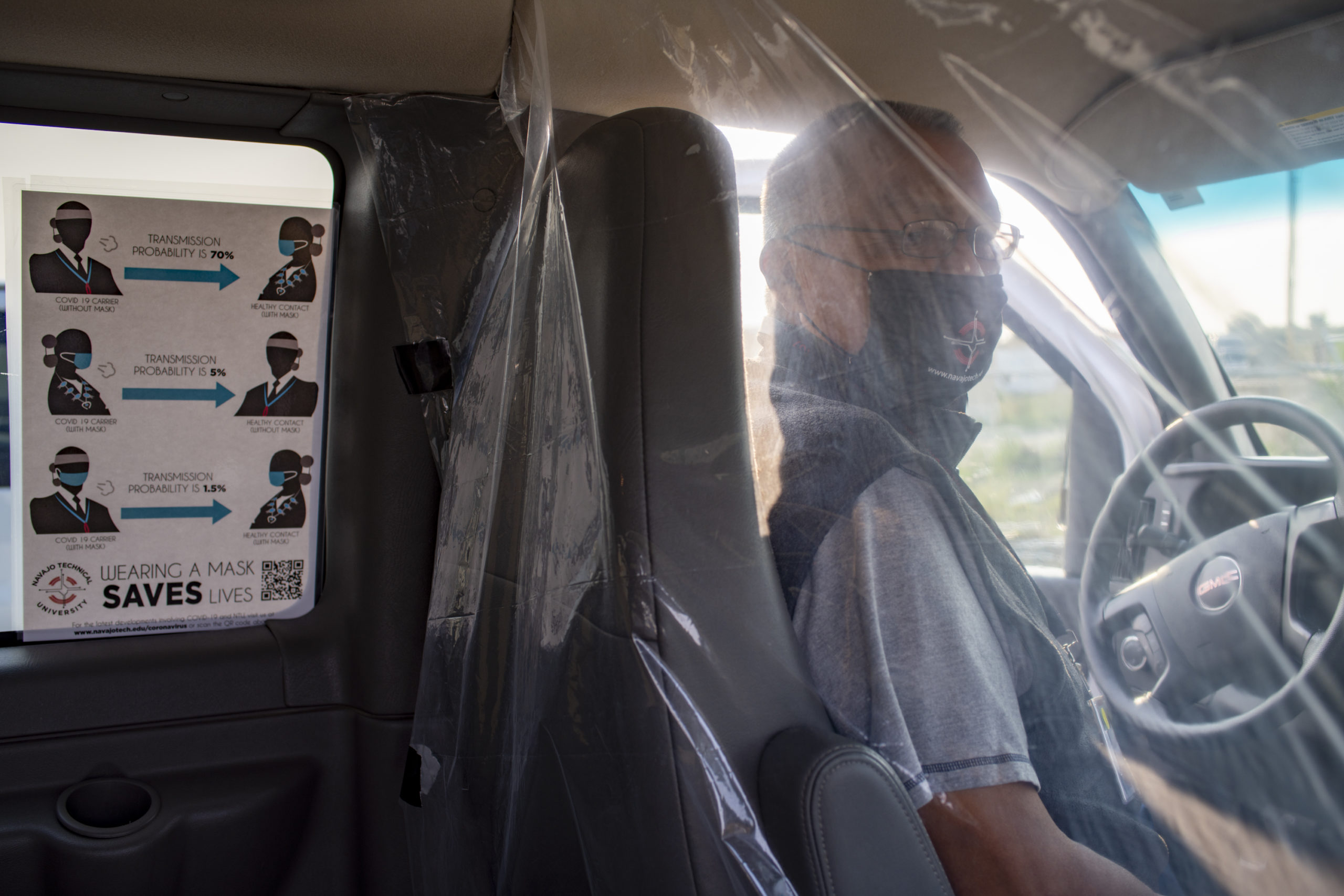The college experience has been reduced to the size of a computer monitor on many college campuses this fall. In an effort to prevent COVID-19 outbreaks, more than 1,000 colleges and universities are fully or heavily relying on virtual learning, including schools on the Navajo Nation – where internet access is notoriously scarce.
How can online learning succeed in a place where students aren’t wired?
For the answer, Searchlight turned to Colleen Bowman, the provost at Navajo Technical University, a small school that’s taken major steps to keep students connected. Based in Crownpoint, on the plains northeast of Gallup, NTU was founded in 1979 as the Navajo Skill Center and has since expanded to four satellite campuses.
This story originally appeared at Searchlight New Mexico and is republished with permission.
Even before the coronavirus appeared, the challenges for NTU and all schools on the Navajo Nation were enormous. The high school dropout rate on the reservation is one of the highest in the country. Only 8 percent of adults there have completed a bachelor’s degree, according to U.S. census data.
Some 36 percent of Navajo students lack access to broadband internet at home — double the no-access rate of students nationwide, according to the National Center for Education Statistics.
The pandemic put the disparities in stark relief, while adding a host of new sorrows. The Navajo Nation at one point had the highest COVID-19 infection rate in the country. To date, an estimated 9,982 people on the reservation have tested positive for the disease and 536 have died.
When public health orders pushed educators to move out of physical classrooms, NTU knew it would have to accommodate methods that fit a variety of needs — accommodating faculty who were new to remote teaching as well as students and instructors with limited or no internet access.
For starters, the school offered subsidized laptops to students who receive financial aid, cut tuition by half and, with permission from the Federal Communications Commission, extended the school’s internet infrastructure into the surrounding communities. Nearly a month into the fall semester, classes now include a mix of distance and in-person instruction, with reduced class sizes, strict social distancing guidelines and ramped-up sanitation protocols on campus.
For Bowman, the university’s ability to adapt and innovate amid the COVID-19 pandemic underscores the skills and lessons she hopes to instill in her students. We caught up with her on a recent day to ask her more. (The interview has been edited for length and clarity.)
Searchlight: What was the biggest challenge for NTU and its students when you moved to distance learning?
Bowman: Due to this pandemic, we tried to make sure that we created learning environments that could address all of the students, knowing full well that we are on the opposite side of the digital divide of the rest of the world. We are sitting here in Navajo Nation, perhaps somewhat crippled because we cannot ensure internet access to everybody.
Q: How could NTU bridge the gap?
A: We had some permission from the Navajo Nation to run lines so that we could broaden the reach of the internet to different communities.
We equipped our students with hot spots if they were within range of a tower that could get a signal. We made sure that our students were able to have a laptop learning device if they needed to. We purchased a bunch of laptops so that we could do a laptop purchase program. And so the students who are qualified for financial aid could purchase a discounted laptop – high quality, but discounted – from the bookstore using their federal aid.
Q: NTU became an internet provider of sorts: The school extended its internet infrastructure so that it could broadcast wireless internet from towers across the Eastern Navajo Agency. How did that come about?
A: We had to lobby the president of the Navajo Nation to give NTU the permission to do this. They [the Navajo Nation government] had some openings from the FCC for internet airspace, and we were able to be given permission to use some of that and create our own lines. I was like, ‘oh my gosh, we’re actually serving more residents than we thought possible.’
Q: Some students and employees still live in areas without connectivity. How do they cope?
A: One of my employees walks to the top of a hill behind her home to catch the signal and conducts Zoom meetings from there. That’s just what we have to do because with the mountains and the terrain, the [broadband] signal gets interrupted or it gets blocked.
Q: You also launched a program called Homework Express, to deliver paper homework assignments to students in remote areas. Why is that important?
A: We have students who either don’t have a vehicle to get to a signal, or it’s a challenge for them to get to the campus. … Our reservation is so expansive — a lot of the students that we are assisting live beyond the radius of an internet capability.
Q: Homework Express involves NTU bus drivers who drop off and pick up homework. How exactly does it work?
A: They’re running like a modern-day Pony Express. Once the faculty members have established a connection with their students and they know exactly who’s having the challenges and who is requesting that paper copy, they send the homework assignments over to the print shop. They print it, package it up, and walk it over to the NTU transportation director’s office. He gets the details, gets the information, and gives it to the drivers.
Q: You’ve said that students are really motivated to get their homework. But if their families don’t have a vehicle, how do they get to the drop-off spots?
A: Some of them hitchhike to where the [Homework Express] point is.
Q: You also offered prepaid fuel cards to some students. Why?
A: If they can get to the campus parking lot, they can work out of their cars. If they need to get to the Homework Express drop-off line, at least they have the resources to get there. So we tried [to help them] every which way possible. I was even considering [jokingly], ‘why don’t we just get a big giant drone and let’s just drop off homework that way.’ But we never got that far.
Q: Have there been some surprising difficulties for teachers who switch to virtual learning?
A: Everybody thinks when you move to online, it’s going to be easy. It’s not. … There’s a myriad of things that you have to consider — the learning modalities of all your students, accessibility, am I gonna have to do this part of it in print? Am I gonna have to do this face to face? Do I have the skill sets to teach this online?
And I imagine it’s like that everywhere. Because educators are used to face-to-face interaction, looking into the eyes of our learners to see, ‘did the lightbulb go on?’
Q: More than 88,000 COVID-19 cases have been reported at colleges around the country in recent weeks. How did you make students feel safe about enrolling this fall semester?
A: We established protocols on how classroom safety was going to be, how lab protocols were, separating out social distancing, all of that. So we were testing it all along. And we still were very uncomfortable. And our [enrollment] numbers were showing that everybody else was uncomfortable. Well, we decided we need to go all in.
We all met and decided we’re going to do half-off tuition.
Q: Did enrollment increase?
A: [As of August 17, the last day to change enrollment for the fall semester] we were up to 928 students. Last year on the same date, we had 1,131. I’m glad that we have the numbers that we have right now: They were hard-fought.
Q: You also have students in the dorms. What’s campus life like for them?
A: A lot of rules were put in place. And so the people who are living in the dorm – I think right now we have 41 students in the dorm — are all very quiet. They’re very concerned about health and they just go to class and they go right back to their rooms. They’re trying to get through the semester with no incident of COVID. They’re serious about it.
And then we have commuters, and it runs the gamut. You have those who don’t believe it’s real. Those that are wearing blinders, those that refuse to abide by rules. But our university has adopted the rule: You come on campus, you wear a face mask, you social distance, you wash your hands, and you be respectful of others that are on campus as well.
Q: What are you hoping students and faculty will take away from all the adversities?
A: I shared this with our staff, our faculty, and our students. I said we’re living through something that people have never experienced before in the past hundred years. You’re going to be able to be an elder in a community somewhere on the reservation, many, many years down the road — an educated elder who will be able to tell your grandchildren or your great-grandchildren: This is how you be the resilient individual that you can be. This is how you learn how to be resourceful, flexible, supportive, respectful and successful, and be a quality contributing member of society.
Searchlight New Mexico is a non-partisan, nonprofit news organization dedicated to investigative reporting in New Mexico.


















